Since the launch of Binance Spot in May, SYRUP has surged more than double against the trend.
Written by: @defi_gaz, Castle Labs
Translated by: Alex Liu, Foresight News
This cycle has been challenging for many. If one word could describe it, it would likely be "extraction."
Crypto-native funds are circulating at an unprecedented speed, leaving even the most seasoned "gamblers" feeling dizzy. Major protocols are doing everything they can to launch various incentives, trying to attract limited liquidity to their products, even if these funds only stay for a few days before the next hot spot emerges.
Meanwhile, Bitcoin's dominance has continued to rise since the low in November 2022, primarily due to seemingly endless institutional buying.
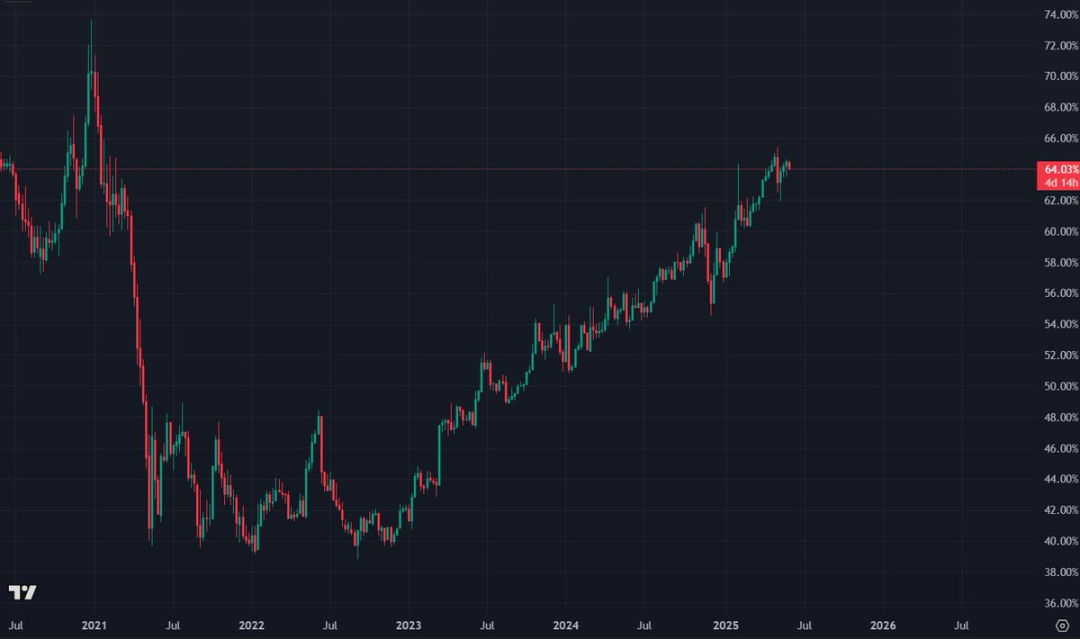
Bitcoin market share, data: TradingView
The implications are clear.
There is no doubt that the crypto market is maturing. We are finally seeing the regulatory clarity needed to drive the next phase of industry development, and many protocols are shifting their target user groups to different types of participants.
The giants have arrived, and they come with substantial capital.
We have already seen the influence of these large institutions. The entire Real World Assets (RWA) sector is steadily growing, with the current Total Value Locked (TVL) climbing to approximately $12.6 billion.

Many leaders in this field are developing products aimed at institutional capital participation, some of which are even built directly by the institutions themselves.
Among emerging projects, Maple Finance stands out with its rapid growth in revenue and Assets Under Management (AUM). This rapid growth is clearly reflected in the price trend of the SYRUP token, showing no signs of slowing down.
What is Maple Finance?

In summary, Maple Finance aims to bring asset management on-chain by providing a suite of financial products tailored specifically for institutions, with a particular focus on lending.
The team was established in 2019 and has a strong background in traditional finance. They understand the conditions required for large institutions to enter the crypto world at scale.

Maple adopts a minimalist strategy regarding the types of collateral used on its platform, focusing only on the top blue-chip tokens and stablecoins—exactly the types of assets that large institutions are eager to access.
The data speaks for itself.

Source: Maple Finance Dune Dashboard
According to the latest data from the Maple Finance Dune Dashboard, its total Assets Under Management (AUM) is approximately $2.2 billion, having grown by over $1 billion since early May. This represents an astonishing 5-fold increase compared to data from January 1, 2025.
The active outstanding loans on the platform have also seen similar growth, increasing by about 30% in May.
Maple's revenue performance is equally strong, with recent monthly revenue surpassing $1 million, a 61.21% increase from April. Since March 2023, its monthly average revenue growth rate has remained around 28%, showing a clear trend.
This revenue primarily comes from interest sharing charged to borrowers and the returns generated from depositing collateral into DeFi protocols.
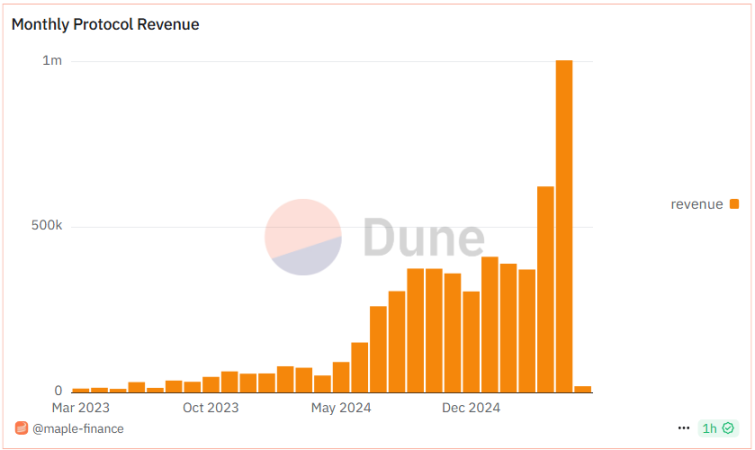
Source: Maple Finance Dune Dashboard
Maple has three unique lending products that contribute to its impressive performance:
High-Yield Products: Net Annual Percentage Yield (APY) of 9%, using BTC, ETH, and a select group of top altcoins as collateral.
Blue-Chip Lending: Net APY of 6.9%, using only BTC and ETH as collateral.
Bitcoin Yield: Allows large institutional Bitcoin holders to earn a net APY of 4-6% on their held BTC.
It is worth noting that higher-yielding products require a higher over-collateralization rate to compensate for the greater volatility of the underlying assets used as collateral.
In-Depth Analysis of Maple
Maple is quickly becoming the preferred platform for large institutional borrowers. Its rigorous borrower vetting process—ensuring they can meet financial commitments—is key to distinguishing it from other lending protocols.
These licensed borrowers must undergo an in-depth underwriting process to assess their balance sheet strength and ensure they have the operational capacity to meet margin calls in a down market.
The underlying collateral is held by institutional-grade custodial solutions, and Maple provides on-chain collateral verifiability, allowing lenders to view the collateral details for each outstanding loan.
With liquid blue-chip tokens as collateral and proactive, institutional-grade collateral management, Maple can consistently and securely offer yields above market levels.
Thanks to the process of filtering for the best borrowers and highest quality collateral, along with a focus on short-term loan durations, liquidation events are extremely rare within the Maple ecosystem.
SYRUP Token
The SYRUP token is Maple's native token.
SYRUP is used for platform governance, incentivizing participation through staking, and allowing holders to benefit from the growth of the Maple ecosystem.
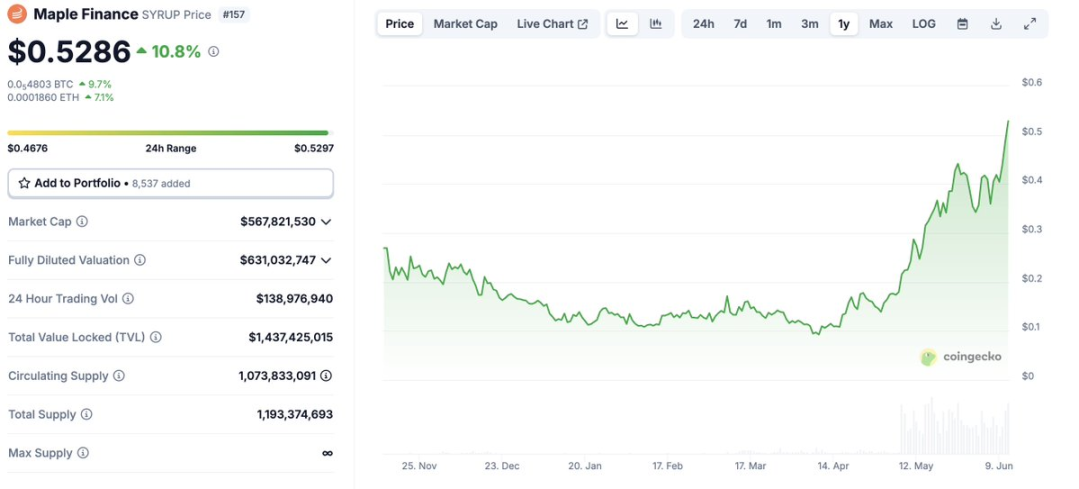
Currently, of the 1.07 billion SYRUP tokens in circulation, approximately 42.7% have been staked on the platform.
Stakers can earn rewards from Maple's token buyback (thanks to the protocol's revenue) and receive an annual yield of 2.7%, with no lock-up period.
The release schedule for SYRUP is approximately 5% per year, continuing for 3 years from inception. This means all SYRUP tokens will be fully circulated by September 2026.
syrupUSDC/USDT and Drips Rewards
Users lending USDC or USDT to the Maple platform will receive corresponding liquidity certificates (LP Tokens): syrupUSDC or syrupUSDT. Upon receiving syrupUSDT, users will immediately start accumulating a 6.6% annual yield, which can be used across various DeFi platforms.
The annual yield for syrupUSDC is approximately 10.6%, outperforming protocols like AAVE, Ethena, and Compound. Coupled with its extreme focus on security, Maple has become the preferred choice for users seeking to maximize stablecoin returns.
In addition to earning yields and DeFi use cases by depositing USDC or USDT, lenders will also receive Drip rewards. These rewards can be converted into more staked SYRUP tokens at the end of each "season," allowing users to compound their SYRUP holdings over time.
Drips themselves compound every 4 hours, enhancing the total annual yield for SYRUP stakers.
Partnerships and Integrations
In recent months, Maple has secured several notable partnerships and plans to continue expanding its network in both crypto and traditional finance.
April 2025: Announced a significant partnership with Spark, including a $50 million investment in syrupUSDC.
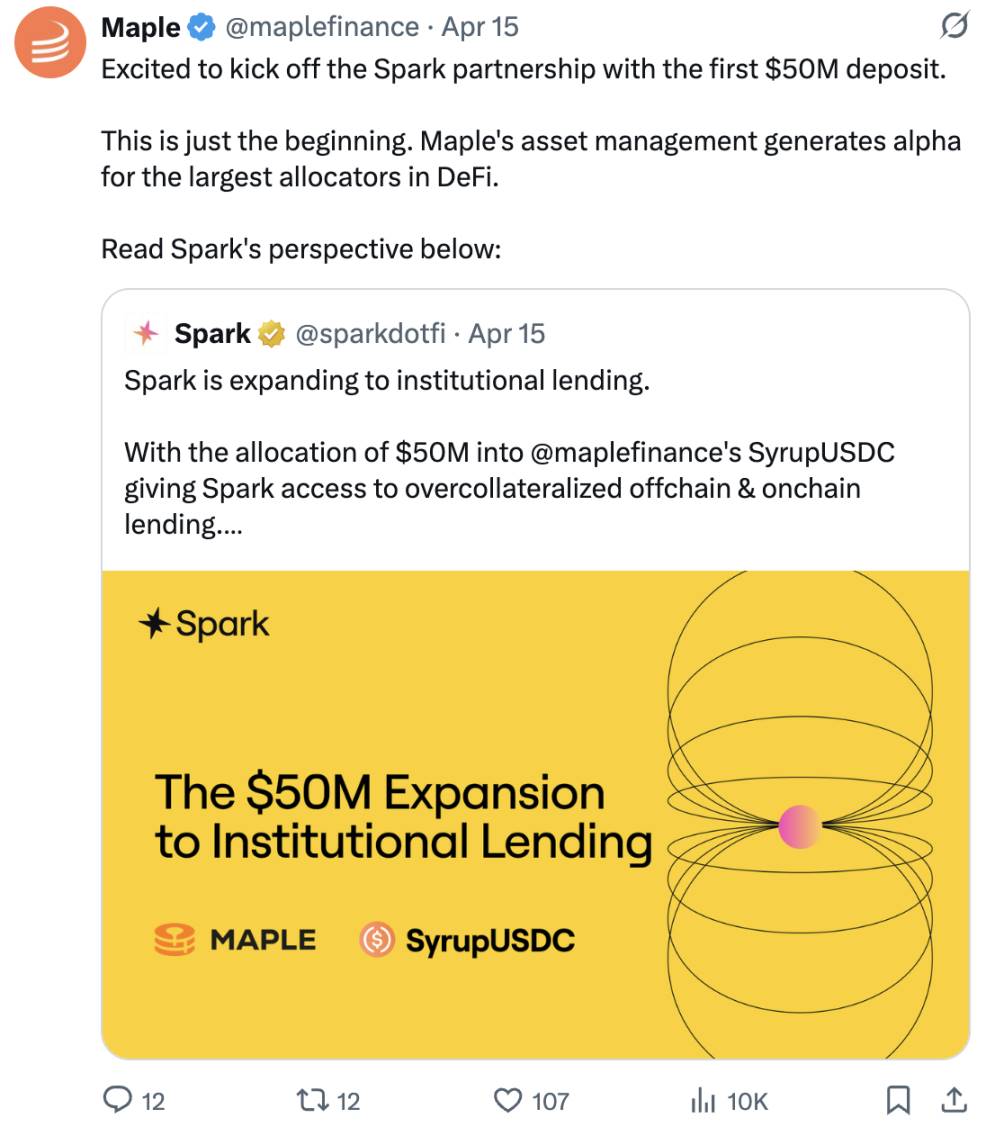
March 2025:
Bitwise joined and began allocating funds to the Maple ecosystem, further solidifying Maple's position as the preferred ecosystem for large institutional capital.
Maple announced its entry into the Convergence ecosystem. This initiative, led by Ethena, integrates protocols like Pendle and Morpho, aiming to accelerate the on-chain adoption rate of institutional-grade Real World Assets (RWA).
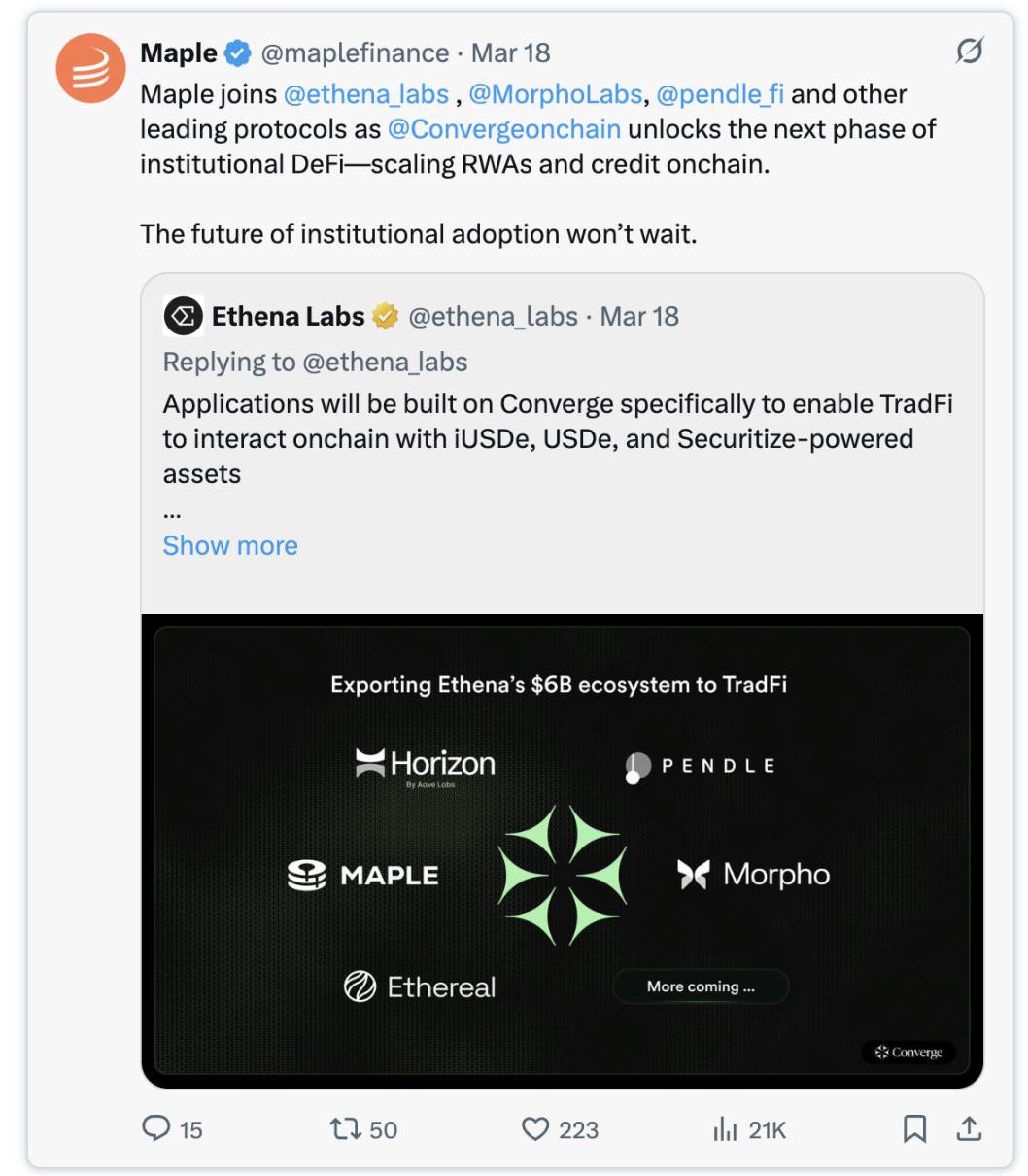
February 2025: The Core Foundation partnered with Maple to announce the launch of the lstBTC product, a liquid, yield-bearing Bitcoin token designed for institutions to earn returns on their held BTC.
May 2025 (most recent): Maple completed its first Bitcoin collateral financing from global investment bank Cantor. This opened a $2 billion initial financing channel for institutional Bitcoin holders to leverage their BTC through the Maple ecosystem.
Additionally, for users looking to enhance returns through syrupUSDC while also receiving up to 5x multiplier Drip rewards, the integration of syrupUSDC with Pendle is an ideal choice.
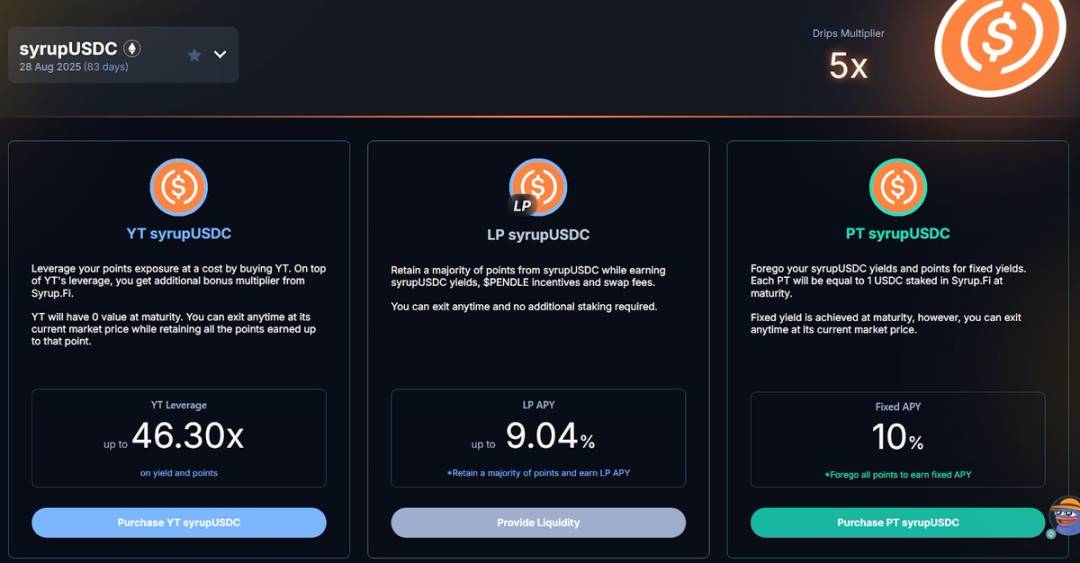
Competitive Landscape
The field in which Maple Finance operates primarily consists of large funds, family offices, and high-net-worth individuals as its client base.
Due to Maple's underwriting of its loans and the requirement for all borrowers to complete the KYC (Know Your Customer) process to prove their creditworthiness, it occupies a unique niche between DeFi and centralized finance (CeFi).
This addresses two major issues present in the past DeFi and CeFi models:
Large institutional participants are concerned about the risks involved in deploying capital on-chain through decentralized platform providers.
The process of obtaining credit through traditional financial methods or within the centralized finance provider world is slow, costly, and heavily restricted.
Maple aims to solve these two problems through a hybrid approach: combining the over-collateralization common in DeFi lending protocols with the typical strict compliance, credit assessment, and borrower underwriting found in the traditional financial world.
Compared to other platforms in the field, we are beginning to see Maple's undervalued potential.
For example, Ondo Finance has a TVL of approximately $1.3 billion, a market cap (MC) of $2.6 billion, and a fully diluted valuation (FDV) of about $8.36 billion.

BlackRock's Buidl has a TVL of about $2.9 billion, with a market cap also at $2.9 billion (considering fully diluted tokens).

Meanwhile, Maple currently has a TVL of $2.2 billion, but its market cap is only $567.8 million. Even considering fully diluted valuation, its valuation is only about $631 million.
Based on the comparison of TVL to market cap, the potential upside for Maple compared to its competitors seems very clear.
Clearly, this is a very basic method of value assessment, and many factors need to be considered when evaluating the future potential of a protocol; however, it quickly reveals the value discrepancies present in the current institutional lending space.
As the entire sector continues to grow, Maple's recent growth rate places it in a position likely to outperform its competitors—provided that its growth can maintain the current pace and does not flatten out in the short term.
Conclusion
As a relatively new participant in the decentralized institutional lending space, Maple is well-positioned to capture a significant market share in the coming months and even years.
Their goal is to achieve a TVL of $4 billion by the end of this year, broken down as follows:
syrupUSDC/USDT: $1 billion
Bitcoin yield products: $1.5 billion
Other Maple institutional product suite: $1.5 billion
Whether they can achieve these goals remains to be seen, but the outlook has been positive so far.
As the entire crypto market matures, projects with solid fundamentals are more likely to gain market share as the type of investors shifts from retail to institutional.
These institutional participants are likely to look for the types of metrics they typically focus on in the traditional financial world. Price-to-earnings (PE) ratios, revenue generation capabilities, and moats will be their primary concerns when entering the space.
Therefore, following their lead, extending our investment time horizon, and seeking out those protocols with real fundamentals (rather than the previously crucial "hype fundamentals" - pumpamentals) is likely to yield returns.
免责声明:本文章仅代表作者个人观点,不代表本平台的立场和观点。本文章仅供信息分享,不构成对任何人的任何投资建议。用户与作者之间的任何争议,与本平台无关。如网页中刊载的文章或图片涉及侵权,请提供相关的权利证明和身份证明发送邮件到support@aicoin.com,本平台相关工作人员将会进行核查。




